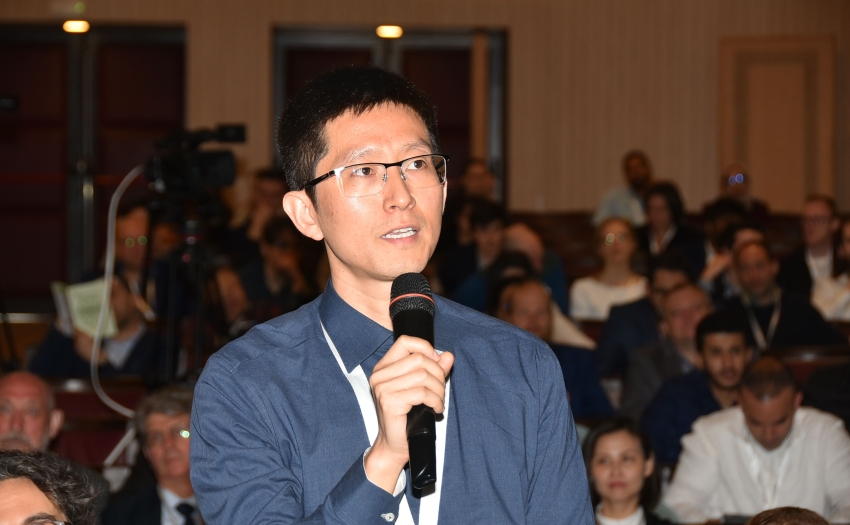News

Interview with Dr Guoqing Geng, 2023 RILEM Colonnetti medallist
Dr Guoqing Geng is an Assistant Professor at the Department of Civil and Environmental Engineering of the National University of Singapore. Dr Geng joined RILEM in 2011. He has been DAC Regional convener for East Asia since 2022. He is one of the two 2023 RILEM Colonnetti medallists. The presentation of Dr Geng at the Colonnetti award ceremony during the RILEM Spring Convention this year, in Rabat, Morocco, titled “How does new experimental method benefit our cement & concrete study?” is available here. The 2023 Colonnetti paper of Dr Geng The missing link in the bottom-up theory of mechanical properties of calcium silicate hydrate is published in RILEM Tech Lett, OPEN ACCESS!
28 March 2023
***
Daniela Ciancio – RILEM Implementation Manager (RIM): I can see from your CV that you joined RILEM in 2011. I can also see that you are a Chinese person that moved first to Berkeley, USA, then to Switzerland and finally landed in Singapore. Can you tell us more about your studies?
Dr Guoqing Geng (Guoqing): I met RILEM in 2011, so more than 10 years ago, when I was a fresh graduate student in China in Southeast University. It is one of the best universities for research in China, with many prestigious professors and researchers, and a lot of students that graduate every year there and doing good research on cement and concrete. I was among one of them in 2011. RILEM organised a PhD course in Nanjing that year (Editor’s note: it was the Cement and Concrete doctoral course). I remember at that time the lecturers were Prof. Karen Scrivener, Prof. Jason Weiss, Prof. Ole Jensen and a few others. I participated in the PhD course and after that I became a student member of RILEM. That was my very first interaction.
RIM: What happened then?
Guoqing: Shortly after that, I went to the United States to UC Berkeley for my PhD. At that time, I was more in the US hemisphere and people talked more about ACI… And also since I didn't use a proper e-mail address when registering as a student member of RILEM, I kind of lost contacts with RILEM for a few years.
RIM: I see!
Guoqing: When I graduated from my PhD in 2017, I was looking for a postdoc position. The searching led me to a project in Switzerland. It was a collaborative project from several laboratories, working together to understand the alkali-silica reaction problem. One of the participant labs was from the Paul Scherrer Institute (Switzerland), where there was access to Synchrotron facilities. That's what I did for my PhD, and I immediately wanted to use what I learned in my PhD to study this specific problem: alkali-silica reaction. So, I joined this big project. I stayed there for more than 2 years and worked with quite a few researchers until late 2019, when I was offered a position in Singapore. It was really hard to say goodbye, but my supervisors and mentors encouraged me to take the new position. After I joined NUS, Covid started. I struggled to connect with friends in Europe and then I realised that I could do it in a much better way, which was by joining RILEM! RILEM has so many good TCs (Editor’s note: Technical Committees) and it is just so easy to see what others are doing by attending regular TC meetings. I benefit a lot from being a TC member. I started new research activities here and without the information from the TCs it would be very hard for me. So, this is my story - I started from RILEM education courses, and then reconnected through TCs.
RIM: When were you invited to become a regional convener? And who invited you?
Guoqing: I'm not completely sure who initiated that, but I think my name was proposed by someone during one of the DAC meetings. Then I got contacted by Prof. Pietro Lura from EMPA (Editor’s note: Prof. Lura is the former RILEM treasurer). He asked me whether I wanted to serve as a regional convener for the East Asia region. It was a question I didn’t need to think about.
RIM: How was your time at UC Berkeley?
Guoqing: It was quite a cultural shock. I was very young, and things were new and exciting.
RIM: You continued your studies there with a PhD.
Guoqing: Yes. Though I felt I was trained well in China to be an entry-level researcher, I realized that there were so many unknowns to me. In Berkeley I explored different experimental methods, some I never heard of before, and with all the training and practise I felt I was in a much better shape for doing research independently.
RIM: Are you a civil engineer? What is your background?
Guoqing: In my undergrad in China, I was trained in the domain of materials science with a focus on cement and concrete. After all these years of concrete studies, I would now call myself a civil engineer, a researcher and educator of construction materials.
RIM: How many times did you apply for this medal?
Guoqing: This is the second time. I feel lucky. I know it's very competitive. I tried for the first time during my first year in Singapore. I just wanted to give it a try and to receive some feedback. Then I decided to remain a bit silent in the following two-three years because I wanted to apply again when I felt I was ready. Last year was my last chance because of the age limit. So… I told myself to go for it.
RIM: Can you tell us more about your research? How would you describe your research and why do you think it's important?
Guoqing: Well, if you asked any of the winners of the Colonnetti medal to use one sentence to summarise their work, I think it would be more or less the same “We study construction materials and we develop new and better construction materials”. The uniqueness of my approach is that I use synchrotron-radiation facilities to study concrete. It's different from most of the researchers who use laboratory equipment. There's no good or bad though.
RIM: … alternative?
Guoqing: Synchrotron facilities offer a long list of technologies that you can use to study cement hydration, to study the microstructure of concrete, to study the mechanical property, the long-term degradation, etc… It's just that the experimental setup is a bit different. The high flux of synchrotron X-ray and fine scanning capability enables me to look at fundamental processes, such as the atomics structure of nano-crystalline C-S-H. Meanwhile, I would like to mention that now I'm extending my directions. In Singapore, the driving force of doing research comes a lot from the real need of the community. It's a small country, a city state. It has limited resources, so whatever we do, we make sure it's useful. Researchers here focus on very realistic problems. I no longer focus only on theoretical questions. I work on topics such as whether we can use local resources, low grade material, or waste material, for sustainable construction. The purpose is to reduce the amount of waste that we have to deal with, and also to reduce our reliance on importing from other places. I believe this is not just a Singapore approach, but a global trend. To give an example, I work on incineration ash from the municipal waste combustion process, and on the excavation waste from the underground projects. They are potentially useful if we treat them properly.
RIM: What about your activities as a TC member?
Guoqing: I'm a member of three TCs (Editor’s note: 281-CCC - Carbonation of concrete with supplementary cementitious materials, 282-CCL - Calcined Clays as Supplementary Cementitious Materials, and 289-DCM - Long-term durability of structural concretes in marine exposure conditions). They focus on durability problems, particularly in marine condition. In TC 289-DCM, I helped with one working group to develop some guidelines of establishing an exposure site for long term marine condition exposure. In the other 2 TCs, I'm not very active and mostly a listener. I think also the reason is because when I joined in, the work of the TC was already well established.
RIM: I see.
Guoqing: My interaction with the RILEM TCs is quite solid. I encourage my students and postdocs to join them too. Now in my group I have at least six students involved in TCs activities. I'm very interested in the new TCs too, for example, recently there's this new TC on moisture ingress, which is very relevant to my research of concrete degradation in tropical environment (Editor’s note: MMS - Modelling and experimental validation of moisture state in bulk cementitious materials and at the steel-concrete interface, Chaired by Prof. Zhidong Zhang); so I became a member right after it was approved.
RIM: Thank you for sharing your RILEM life with us today, Guoqing. It has been very nice to hear from you!
 1
1













No comment
Log in to post comment. Log in.